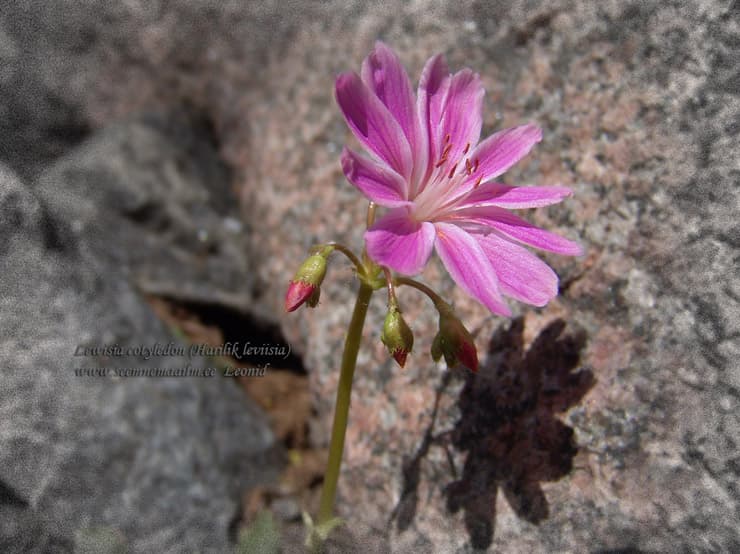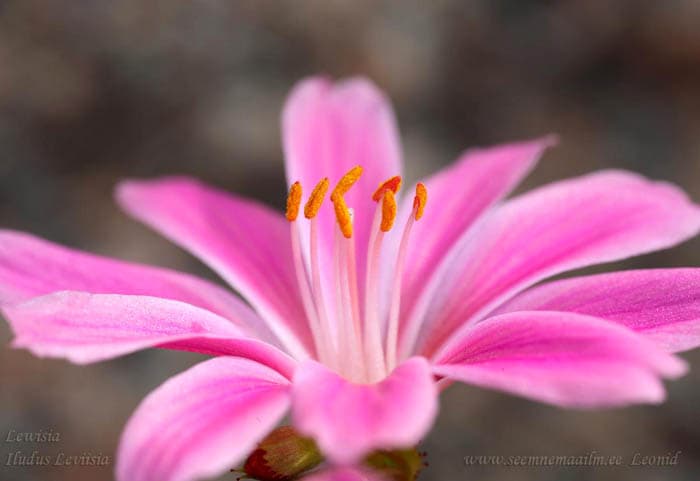Ex Tax: 2.65€
For the rockgarden, flowering pot plant.
IV-VI, Z5-8, 25 cm.
Mixture of many newly bred colors and forms, round flowers also semi-double, from white and yellow to pink, red-orange to blue-red.
The best existing cotyledon hybrids today! Gold medal IGA Stuttgart 1993 (Krämer).

Family: Portulacaceae
Origin: USA: California and Southwest Oregon
Distinction: Gold medal IGA Stuttgart 1993 (Krämer)
Special Features: Mixture of many newly bred colors and forms. The best existing cotyledon hybrids today.
History: The genus is named after Virginian, Meriwether Lewis, leader of the Lewis and Clark expedition, the first to cross the North American continent in 1804-1806.
Colour: White and yellow to pink; red-orange to blue-red
Natural Flowering Period: April - June
Winter Hardiness Zones: Z5-8
Growth Habit: Flat rosettes
Foliage: Fleshy, evergreen leaves form a starfish-like rosette
Height with Flower: 25 cm
Spacing between Plants: 30 cm
Soil Requirement: Gritty, well-drained soils, in warmer conditions a northern exposure with a cool root run is preferred, pH 5.8 - 6.8
Location: Full sun or partial shade
Use: Great for containers or in the rock garden. Plant together with Aquilegia "Calimero", Gypsophila cerastiodes and Heuchera villosa var. macrorrhiza
Specialities: A very attractive plant for container production and will have impulse appeal in garden centres
Cultural Tips:
Grams per 1000 seeds: 0,667
Seeds per Gram: 1500
Seeding Recommendation: 1 g / 1000 plants
Sowing Rate: 4 seeds per cell
Plug tray recommended size(s): 72 or 128
Germination: The sowing must be kept warm (about +18 to 22°C) and moist for the first 2-4 weeks. After this period the sowing must be kept at a cold temperature (between -4 and +4°C) for another 4-6 weeks. It is not so important if the temperature is higher or lower during the cooling period, but the cooling period has to be prolonged because the synthesis of the germination inducer, hormonlike acid, slows down or comes to a standstill.
It is beneficial to cover the sowing with snow during the cooling-period. The temperature below it usually keeps in the optimum range of -4 to 0°C. The sowing is kept moist, and the melting snow helps to destroy the shell, which is advantageous for the germinating seedling. After this cooling-period the sowing may not be immediately exposed to high temperatures. The most effective temperatures are between +5 to 12°C , even if germination has started. The best location for this sowing, even in March, April and May, is the open field, the cold frame or a cold greenhouse.
Scheduling:
Best Sowing Dates: November - March
Sowing to Germination: 8 - 10 weeks
Germination to Transplant: 4 - 8 weeks
Transplanting to Salable Plant: 6 - 10 weeks
Cutting-Back at Transplanting: Not Necessary
Growing On:
Container Size(s): 1 plug per 8/9 cm; 1-2 plugs per 11/12 cm
Vernalization: A prudent recommendation would be to provide 6-12 weeks at an average daily temperature of 5°C. Exposure to cold may not be necessary for flowering but might improve quality.
Forcing: An obvious place to experiment - following vernalization - would be raising daytime temperatures to 15° - 17°C. Provide 16 hours of continuous lighting. During the short days of winter, provide a night interruption lighting of 4 hours between 10:00 p.m. and 2:00 a.m.
Fertilization: Light (100-150 ppm).

Bitter-Root "Rainbow" (Siskiyou bitterroot; Siskiyou Lewisia).















